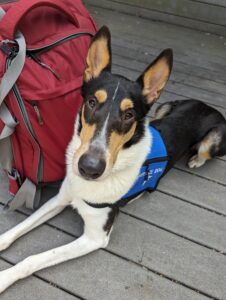Traveling is challenging for service dogs and their partners. The combination of crowds, noise and unfamiliar locations can be stressful, even for experienced service dogs. There are a number of different strategies that trainers can use to help teams prepare for these situations.
Introducing service dogs in training to public transportation settings gradually and slowly is an important way to help dogs feel more confident in these environments. A great way to begin is by working outside of train stations and airports, starting during quieter times and gradually working toward busier periods. Keeping these training sessions short and incorporating regular sniff breaks can help allow the dog to decompress.
Breaking down the various challenging aspects of transportation settings to work on them individually is another useful technique. For example, introduce the dog to rolling luggage in a controlled environment such as a training facility or the owner’s home first. Additionally, using recordings of sounds commonly heard in airports and train stations, such as crowds and voices on loudspeakers, can help familiarize the dog with these noises. These recordings can be played at a low volume when the dog is at home, on a comfortable dog bed while engaged with a long-lasting chew. Gradually increase the volume over a few days or weeks, ensuring that the dog remains relaxed.
Rehearsal is also valuable in preparing service dogs for travel. There are numerous opportunities to practice behaviors needed for navigating public transportation, such as long downs and holding a stay to get through security checkpoints. Have a volunteer assume the role of a Transportation Security Administration (TSA) agent to allow the team to practice the necessary behaviors with the dog in a controlled setting. For example, have the handler remove their shoes and answer questions asked by the “TSA agent” while rewarding the dog for waiting quietly by the handler’s side. Some service dog organizations are able to arrange practice opportunities with TSA agents at airports during non-busy times. Trainers working with owner-trained teams may not have access to this kind of support but may be able to find other locations in the community where they can practice going through similar security protocols. For example, in my area, some museums have security screening checkpoints and metal detectors.
In addition to preparing the service dog, it is equally important for trainers to educate the human part of the team. Handlers need to learn how to interpret signs of stress in their dogs and to provide opportunities for decompression as soon as possible upon reaching their destination. Service dog handlers must also consider the dog’s needs throughout the trip, including identifying dog relief areas, planning where the dog will be positioned during transportation, and ensuring the dog’s downtime, exercise and enrichment needs are met. Depending on the dog’s age, experience and individual requirements, handlers may need to adjust their activities to accommodate the dog’s wellbeing. For example, by ordering room service instead of going out to dinner upon arrival, handlers can give their dogs a quiet opportunity to relax.
Learn how to help service dogs succeed in public access with our on-demand course:
Getting Started in Public Access
Traveling with a service dog means the owner needs to plan for additional luggage and paperwork. The dog will need supplies including food, medications, toys, grooming equipment and any other routine needs. Service dog handlers should also be prepared with essential information such as the phone number and location of emergency veterinarians at their destination, the dog’s medical records and the required Department of Transportation forms for air travel.
Traveling with a service dog is not the best choice in all cases. In some situations, the benefits of the dog’s help may be outweighed by the logistical difficulties. In other cases, the dog may not be ready because of their training or maturity levels. Instead of bringing their service dog, owners might opt to travel with a human caregiver, bring extra adaptive equipment or plan for different ways to accommodate their needs. If this is the client’s choice, the trainer can assist by providing guidance on how to assure the service dog is appropriately cared for while they are away.
Whether clients choose to travel with their service dogs or explore alternative accommodations, trainers can take steps to help their clients meet the dog’s needs in these difficult settings, leading to successful, happy experiences for both ends of the leash.

